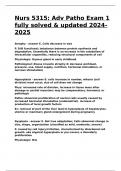Nurs 5315: Adv Patho Exam 1
fully solved & updated 2024-
2025
Atrophy - answer E. Cells decrease in size
P. Still functional; imbalance between protein synthesis and
degradation. Essentially there is an increase in the catabolism of
intracellular organelles, reducing structural components of cell
Physiologic: thymus gland in early childhood
Pathological: disuse (muscle atrophy d/ decrease workload,
pressure, use, blood supply, nutrition, hormonal stimulation, or
nervous stimulation)
Hyperplasia - answer E: cells increase in number, mitosis (cell
division) must occur, size of cell does not change
Phys: increased rate of division, increase in tissue mass after
damage or partial resection; may be compensatory, hormonal, or
pathologic
Patho: abnormal proliferation of normal cells usually caused by
increased hormonal stimulation (endometrial). increase of
production of local growth factors
Ex: removal of part of the liver lead to hyperplasia of hepatocytes.
uterine or mammary gland enlargement during pregnancy
Dysplasia - answer E. Not true adaptation; Cells abnormal change in
size, shape, organization (classified as mild, moderate, severe)
P. caused by cell injury/irritation, characterized by disordered cell
growth. aka atypical hyperplasia or pre-cancer, a disorderly
proliferation
Physiologic: N/A
,Pathologic: squamous dysplasia of cervix from HPV shows up on pap
smear, breast cancer development; pap smears often show
dysplastic cells of the cervix that must undergo laser/surgical tx
Metaplasia - answer E: reversible change, one type of cell changes
to another type for survival
P: reversible; results from exposure of the cells to chronic stressors,
injury, or irritation; Cancer can arise from this area, stimulus
induces a reprogramming of stem cells under the influence of
cytokines and growth factors
Ex: Patho: Columnar cells change to squamous cells in lungs of
smoker or normal ciliated epithelial cells of the bronchial linings are
replaced by stratified squamous epithelial cells.; Phys: Barrett
Esophagus- normal squamous cells change to columnar epithelial
cells in response to reflux, aka intestinal metaplasia
Hypoxia injury - answer E. inadequate oxygenation of tissues
P. decrease in mitochondrial function, decreased production of ATP
increases anaerobic metabolism. eventual cell death.
C.M. hypoxia, cyanosis, cognitive impairment, lethargy
Free radical and ROS - answer E. normal byproduct of ATP
production, will overwhelm the mitochondria- exhaust intracellular
antioxidants
P. lipid peroxidation, damage proteins, fragment DNA
C.M. development in Alzheimer's, heart disease, Parkinson's
disease, Amyotrophic Lateral Sclerosis
Ethanol - answer E. mood altering drug, long term effects on liver
and nutritional status
P. metabolized by liver, generates free radicals
C.M. CNS depression, nutrient deficiencies-Mag, Vit B6, thiamine,
PO4, inflammation and fatty infiltration of liver, hepatomegaly, leads
to liver failure irreversible
,Oncosis - answer Na and H2O enter cell and cause swelling. Organ
increases in weight, becomes distended and pale. Associated with
high fever, hypocalcemia, certain infections
Fatty Infiltration - answer intracellular accumulation of lipids in the
liver
liver fails to metabolize lipids. usually from ETOH or high fat diet.
can lead to cirrhosis
dystrophic calcification - answer accumulation of Ca in dead or dying
tissues
calcium salt clump and harden- interfere with cellular structure and
function
r/t pulmonary TB, atherosclerosis, injured heart valves, chronic
pancreatitis
metastatic calcification - answer accumulation of Ca in normal tissue
result of hypercalcemia r/t hyperparathyroidism, hyperthyroidism,
toxic levels of Vit D. Can also r/t hyperphosphatemia in renal failure
urate accumulation - answer sodium urate crystals are deposited in
tissues- group of disorders collectively called gout- acute arthritis,
chronic gouty arthritis, tophus, nephritis
Coagulative Necrosis - answer kidneys, heart, adrenals- secondary
to hypoxia
Liquefactive Necrosis - answer nerve cells- brain- accumulation of
pus
, Caseous Necrosis - answer lung disease- usually TB- tissue looks like
clumped cheese
Fat Necrosis - answer breast, pancreas, abdominal structures-
creates soaps
Gangrenous Necrosis - answer Dry- dark shriveled skin
Wet- internal organs- can lead to death
Gas- from clostridium- antitoxins and hyperbaric therapy
Gout - answer E. disturbances in serum urate levels. uncommon for
< 30 years old.
P. uric acid is deposited in the tissues of kidney, heart, earlobes, and
joints.
C.M. inflammation, painful joints. result of diuretic use or diet high
in cream sauces, red wine, or red meat
Rhabdomyolysis - answer E. cell hypoxia caused by severe muscle
trauma, hyperthermia, crush injuries, or severe dehydration
P. hypoxia to cell causes failure of the Na-K pump, causing
accumulation of intracellular sodium, oncosis, and eventual cell
death. Cell death releases enzymes such as CK, uric acid, LDH, AST,
etc.
C.M. Causes: trauma, hyperthermia, crush injuries, severe
dehydration; s/s: CK is 5x upper normal limit, muscle pain,
weakness, dark, reddish-brown urine, hypercalcemia, renal failure
Alpha Fetoprotein Origin - answer Liver and germ cell tumors
Carcinoembryonic Antigen - answer GI, pancreas, lung, breast
tumors




